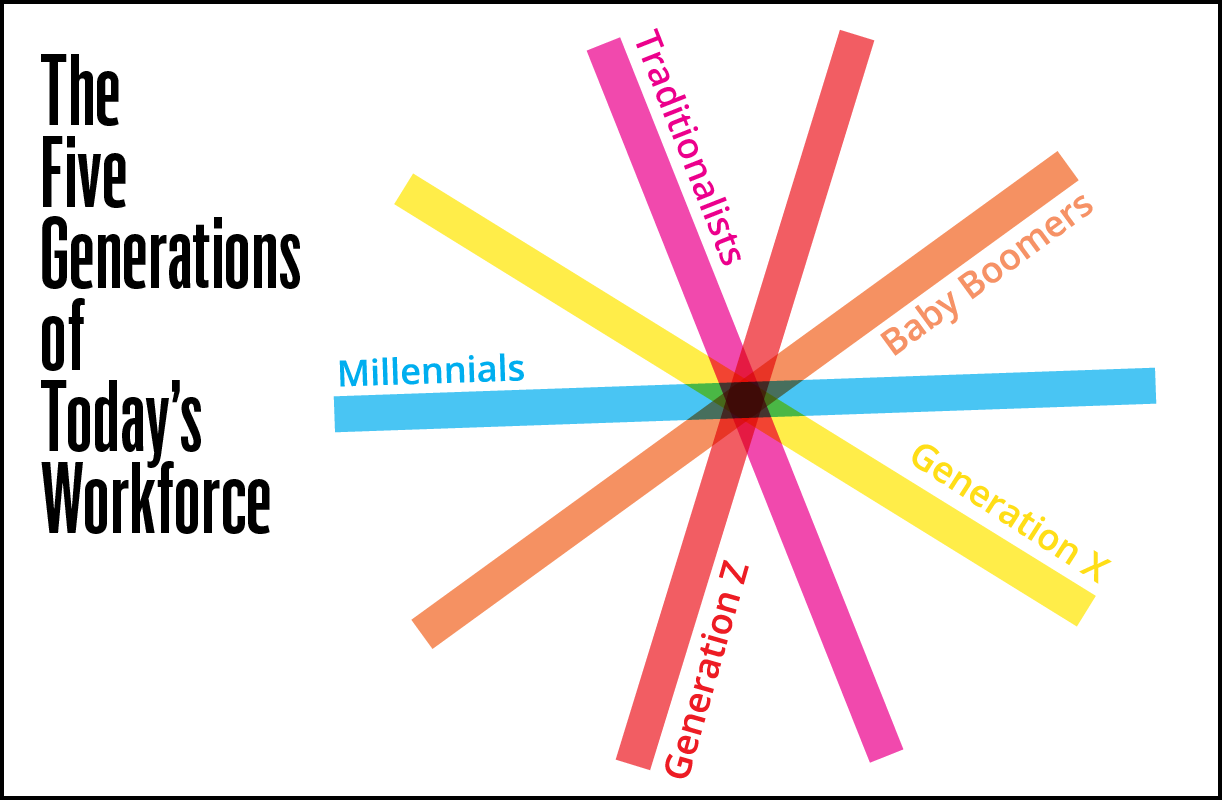
Five generations currently make up today’s US workforce—Generation Z, millennials, Generation X, Baby Boomers, and Traditionalists. Each group has their own set of values and expectations in the workplace, thus creating headaches for even the most acclaimed leaders.
Perhaps no generation in recent years has undergone more scrutiny or has been researched more than millennials. Some say their values clash with traditional corporate norms. Millennials emphasize social responsibility and making an immediate impact rather than having the patience to climb the corporate ladder. And rather than stay with corporations for the length of their career, millennials see job hopping as a viable career-strengthening move.
By 2025, millennials will make up 75 percent of the US workforce, according to a recent Governance Studies at Brookings report. That means the corporate mind-set needs to change, and quick.
Understanding Millennials
When asking millennials what they value most in a workplace, the most common answer is culture, says Diane Adams, chief culture and talent officer at Sprinklr.
“They want a whole life, and if you believe that you have a great whole life, you’re better in the workplace,” Adams says.
Not only does Adams share that same mind-set, she stresses that talent development is more important than talent management. She also emphasizes that personal development should always coincide with professional development. “My personal mission is to inspire and enable others to live extraordinary lives, both personally and professionally,” she says. “When people are at their best—inside or outside of the workplace—everybody wins.”
Culture also encompasses the workplace itself. There’s a reason why a correlation exists between the growing extinction of cubicles and the rising workforce of millennials. This generation places a high priority on collaboration. And as a result, that ping-pong table and kegerator, while nice perks, aren’t going to be enough to retain top talent.
Even legacy companies such as Morton Salt are adapting to this change. As Matt Beliveau explains, he updated the company’s headquarters in Chicago to connect employees and guests to a much deeper understanding of the organization. A massive interactive video wall now allows guests to scroll through information about the company, watch old television commercials, and learn about current initiatives, among other topics.
Every change in the office was implemented with a goal to drive collaboration, health, and happiness. Even the cafeteria is full of healthy snack options, and the open-office layout features adjustable desks and floor-to-ceiling windows. Printers, trashcans, and recycling bins are situated at strategic places. In addition to individual desks, Morton offers booth-like breakout spaces, quiet areas, and conference rooms.
“We didn’t want people to feel chained to their workstations,” says the CHRO of Morton Salt. “By having printers and trash cans scattered around, you’re either more physically active or you’re reducing the amount of paper and waste. We’ve been able to measure that our employees are nearly 10 percent more physically active on a daily basis compared to our old office.”
Bridging the Generational Gaps
Changing the culture and the workplace itself is one thing, but today’s workforce isn’t just made up of millennials. For many leaders, the fear of alienating other generational groups is all too real.
At one end, you have the young go-getters who want to leverage their talent immediately, not wait years for a promotion. And at the other, there are seasoned veterans who have more that they want to offer.
The Five Generations of Today’s Workforce
• Traditionalists: Born before 1945
• Baby Boomers: Born 1946–1964
• Generation X: Born 1965–1984
• Millennials: Born 1985–1995
• Generation Z: Born after 1996
“You can’t think about the workforce as a collective whole,” explains Laura Cushing, vice president of human resources at Loews Corp. “You have to think about it within the context of where people fit in and are coming from, which puts more pressure on managers and leaders. How each generation thinks about their commitment to their employers is different.”
And traditional paths to success don’t apply to younger generations of workers, who tend to prefer jumping from one opportunity to the next versus spending an entire career with one or two employers. Cushing says leaders need to ask themselves how to create an untraditional path so they can attract and retain top talent.
“People want to build skills and competencies through projects, assignments, and tours of duty,” Cushing says. In her opinion, companies need to be more willing to bet on people’s skills. For example, leaders will need to be identified earlier in their career and given increased levels of responsibility at a faster pace. This gives an organization a chance to test people’s capabilities while increasing the likelihood of retaining key talent. “On the other end, there is a role for the population between the ages of sixty and late seventies, which can be valuable to the employee and the employer,” she adds.
The stereotypes surrounding millennials have been known for years—lazy, self-absorbed, narcissistic, entitled, and more. But like it or not, the tide is shifting, and leaders need to catch up now.
“They confound the leadership so much,” said Simon Sinek, best-selling author and motivational speaker, in a conversation with Inside Quest. “Leaders will say, ‘What do you want?’ And millennials will say, ‘We want to work in a place with purpose, we want to make an impact, we want free food, and bean bag chairs.’ Any yet when provided all these things they are still not happy. And that is because there is a missing piece.”
Now, it’s up to leaders to find that missing piece by paying attention to both their personal and professional lives, creating a strong culture and work environment, and collaborating across all generations from the start.
Illustration: Jany Zhang

